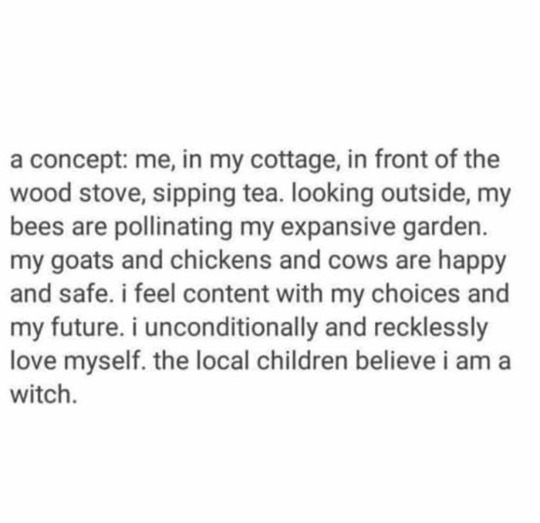A warrior-gang of female cyclists, inhabiting the spirit of the dragyn! We're hosting a FREE* (as long as you can secure transportation to/from) bikepacking adventure in Western Michigan from Friday, July 25th - Friday, July 31st. E-mail us at [email protected] for a free copy of our zine!
Don't wanna be here? Send us removal request.
Text

The initiative was begun by Ashley Scott and Renee Walters, two Black women who wanted to build a safe space for their own families.
"We needed to create a space and a place where we could be a village, again, a tribe, again," Scott said. "We wanted to create this safe space where we can address our own issues and concerns."
47K notes
·
View notes
Text
Feminist Literary Resources - MASTERPOST
Disclaimer: I have not read all of these books and essays. This is not an endorsement of the content of any particular books. I just hoard pdfs and wanted to share. Books I read or am reading are italicized, books that I recommend are bolded.
Full Books
Outlaw Woman - A Memoir of the War Years 1960-1975 Roxanne Dunbar-Ortiz - PDF Link
A Deafening Silence - Hidden Violence Against Women and Children Patrizia Romito - PDF Link
Letters From a War Zone Andrea Dworkin - PDF Link
Our Blood - Prophecies and Discourses on Sexual Politics Andrea Dworkin - PDF Link
Angela Davis - An Autobiography Angela Davis - PDF Link
Assata (Shakur), An Autobiography Assata Shakur - PDF Link
Beyond the Frame - Women of Color and Visual Representation Angela Davis and Neferti Tadiar - PDF Link
Caliban and the Witch - Women, the Body, and Primitive Accumulation Sylvia Federici - PDF Link
Feminism Unmodified - Discourses on Life and Law Catharine A. MacKinnon - PDF Link
Only Words Catharine A. MacKinnon - PDF Link
For Her Own Good - Two Centuries of the Experts’ Advice to Women Barbara Ehrenreich and Deirdre English - PDF Link
Going Out of Our Minds - The Metaphysics of Liberation Sonia Johnson - PDF Link
The Great Cosmic Mother - Rediscovering the Religion of the Earth Monica Sjöö and Barbara Mor - PDF Link
Beauty and Mysogyny - Harmful Cultural Practices in the West Sheila Jeffreys - PDF Link
How to Suppress Women’s Writing Joanna Russ - PDF Link
Loving to Survive - Sexual Terror, Men’s Violence, and Women’s Lives Dee L. R. Graham - PDF Link
Beyond God the Father - Toward a Philosophy of Women’s Liberation Mary Daly - PDF Link
Gyn/Ecology - The Metaethics of Radical Feminism Mary Daly - PDF Link
Sexual Politics Kate Millett - PDF Link
Natural Liberty Sage-Femme Collective - PDF Link
Pornland - How Porn Has Hijacked Our Sexuality Gail Dines - PDF Link
Radical Feminist Therapy - Working in the Context of Violence Bonnie Burstow - PDF Link
Right Wing Women Andrea Dworkin - PDF Link
The Dialectic of Sex - A Case for Feminist Revolution Shulamith Firestone - PDF Link
The Spinster and Her Enemies - Feminism and Sexuality 1880-1930 Sheila Jeffreys - PDF Link
The Sexual Liberals and the Attack on Feminism edited by Dorchen Leidhodt and Janice G. Raymond - PDF Link
This Bridge Called My Back - Writings by Radical Women of Color editors: Cherrie Moraga and Gloria Anzaldua - PDF Link
Toward a Feminist Theory of the State Catharine A. MacKinnon - PDF Link
Trauma and Recovery - The Aftermath of Violence - From Domestic Abuse to Political Terror Judith Herman, M.D. - PDF Link
Unpacking Queer Politics Sheila Jeffreys - PDF Link
Who Cooked the Last Supper? - A Woman’s History of the World Rosalind Miles - PDF Link
Why Does He Do That? - Inside the Minds of Angry and Controlling Men Lundy Bancroft - PDF Link
Wildfire - Igniting the She/Volution Sonia Johnson - PDF Link
Woman Hating Andrea Dworkin - PDF Link
Women, Race, and Class Angela Davis - PDF Link
Essays, Pamphlets, Articles, Manifestos, Letters, Shorter Books
Post-Mortems - Representations of Female Suicide by Drowning in Victorian Culture Valerie Messen - PDF Link
Consciousness-Raising: A Radical Weapon Kathie Sarachild - PDF Link
A Cyborg Manifesto: Science, Technology and Socialist-Feminism in the Late 20th Century - PDF Link
Ancient Hatred and Its Contemporary Manifestation: The Torture of Lesbians Susan Hawthorne, Ph.D. - PDF Link
Racism, Birth Control, and Reproductive Rights Angela Davis - PDF Link
Witches, Midwives, and Nurses - A history of Women Healers Barbara Ehrenreich and Deirdre English - PDF Link
Bringing Together Feminist Theory and Practice: A Collective Interview PDF Link
The Combahee River Collective Statement PDF Link
Compulsory Heterosexuality and Lesbian Existence Adrienne Rich - PDF Link
A Collection of Essays on Feminism and Sexism in the Anarchist Movement PDF Link
Everyday Male Chauvinism - Intimate Partner Violence Which is Not Called Violence - PDF Link
Free Space - A Perspective on the Small Group in Women’s Liberation Pamela Allen - PDF Link
Is Art Creating Patriarchy or is Patriarchy Creating Art? Mary B. - PDF Link
Learning from the Outsider Within: The Sociological Significance of Black Feminist Thought Patricia Hill Collins - PDF Link
Liberalism and the Death of Feminism Catherine A. MacKinnon - PDF Link
Mapping the Margins: Intersectionality, Identity Politics, and Violence against Women of Color Kimberlé Williams Crenshaw - PDF Link
Marx and Gandhi Were Liberals - Feminism and the “Radical” Left Andrea Dworkin - PDF Link
The Subsistence Perspective - Beyond the Globalized Economy Maria Mies and Veronika Bennholdt-Thomsen - PDF Link
Off Our Backs - The Feminist Newsjournal - Issue on Mary Daly PDF Link
Disappearing Ink: Early Modern Women Philosphers and Their Fate in History Eileen O’Neill - PDF Link
Hands, Tools, Weapons Paola Tabet - PDF Link
S.C.U.M. Manifesto Valerie Solanas - PDF Link
Sexology and Antifeminism Sheila Jeffreys - PDF Link
Sinister Wisdom - A Gathering of Spirit - North American Indian Women’s Issue PDF Link
Taking Our Eyes off the Guys Sonia Johnson - PDF Link
We Should All Be Feminists Chimamanda Ngozi Adichie - PDF Link
Why a Materialist Feminism is (Still) Possible - And Necessary Stevi Jackson - PDF Link
Please reblog and share, and add any PDF links that I don’t have!
10K notes
·
View notes
Text
“Women must see that there can be no liberation for them and no solution to the ecological crisis within a society whose fundamental model of relationships continues to be one of domination. They must unite the demands of the women’s movement with those of the ecological movement to envision a radical reshaping of the basic socioeconomic relations and the underlying values of this [modern industrial] society.”
— Rosemary Ruether (via fredarose)
77 notes
·
View notes
Text
“A long-term study of children raised by lesbians found that these children were less likely to suffer from physical and sexual abuse than were their peers who were raised by heterosexuals. This is thought to be due to the absence of adult heterosexual men in the households (Gartrell, Bos, & Goldberg, 2010). Girls raised by lesbians tend to have higher self-esteem, show more maturity and tolerance than their peers, and are older when they have their first heterosexual contact (Gartrell et al., 2005, 2010). Children raised by same-sex parents seem to be less constrained by traditional gender roles; boys are less aggressive, and girls are more inclined to consider nontraditional careers, such as doctor, lawyer, or engineer (Gartrell et al., 2005; Stacey & Biblarz, 2001). Over the course of more than 20 years, scientists studied the psychological adjustment of 78 teenagers who were raised by lesbian mothers. Compared to age-matched counterparts raised by heterosexual parents, these adolescents were rated higher in social, academic, and total competence, and lower in social problems, rule-breaking, aggression, and externalizing problem behavior (Gartrell & Bos, 2010). There are fewer studies of children raised by two men, but gay fathers are more likely than straight fathers to put their children before their career, to make big changes in their lives to accommodate a child, and to strengthen bonds with their extended families after becoming fathers (Bergman, Rubio, Green, & Padrone, 2010).” ~ Martha Rosenthal, Human Sexuality: From Cells to Society, p.247.
418K notes
·
View notes
Photo

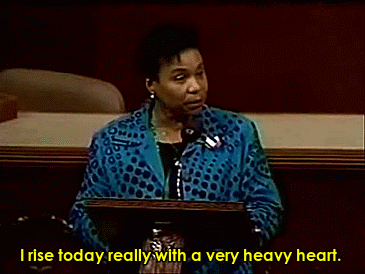
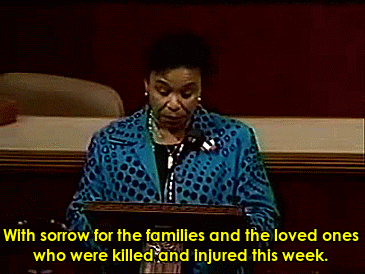

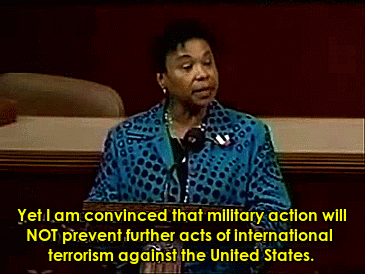
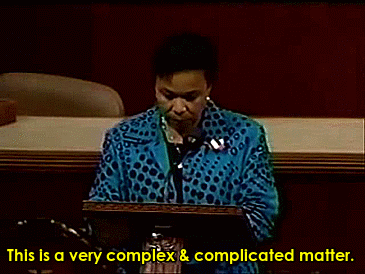
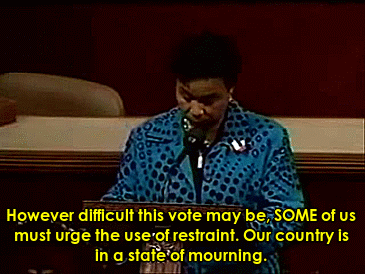
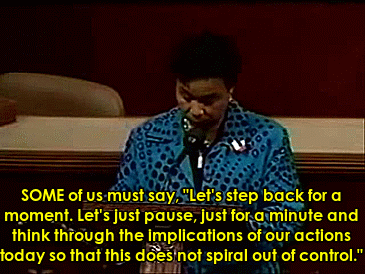


It takes far more courage and wisdom to boldly say “NO” to war when everyone else is saying yes.
Three days after September 11th 2001, Barbara Lee (D-CA) bravely called for a no vote against authorizing George W. Bush’s wars.
In an op-ed she published in The San Francisco Chronicle 9 days later, she explained her vote by pointing out that the resolution “was a blank check to the president to attack anyone involved in the Sept. 11 events — anywhere, in any country, without regard to our nation’s long-term foreign policy, economic and national security interests, and without time limit.” She added: “A rush to launch precipitous military counterattacks runs too great a risk that more innocent men, women, children will be killed.”
For her lone stance, Lee was deluged with rancid insults and death threats to the point where she needed around-the-clock bodyguards. She was vilified as “anti-American” by numerous outlets including The Wall Street Journal. The Washington Times editorialized on September 18 that “Ms. Lee is a long-practicing supporter of America’s enemies — from Fidel Castro on down” and that “while most of the left-wing Democrats spent the week praising President Bush and trying to sound as moderate as possible, Barbara Lee continued to sail under her true colors.” Since then, she has been repeatedly rejected in her bids to join the House Democratic leadership, typically losing to candidates close to Wall Street and in support of militarism. (continue reading from theIntercept)
On this September 11th, in addition to remembering all of the lives lost in America, Iraq and Afghanistan, I choose also to remember Barbara Lee’s brave example in calling for calm, reflective thought before blindly rushing into endless war in the Middle East. Even at the risk of her political career, she stood up and did what was right.
We need more leaders who know that sometimes, it takes more strength to say “no” when everyone else takes the easy way out by saying “yes” to war and militarism.
7K notes
·
View notes
Text
rb if ur female and at some point in your life a male has said he would kill himself in despair if you didn't do/give him what he wanted
2K notes
·
View notes
Text
I don't know why this is not spoken about more in radfem circles (i guess because most radfems are at best gender critical libfems) but ultimately separatism is the only way to bring down male supremacy. Separatism is one of the basic principles of radical feminism. We should all be separatists as much as we possibly can be. (Watch this video by sekhmet she-owl on YouTube for more: https://youtu.be/w_8SrqFoSTg )
youtube
Second wave feminists pretty much figured out that this was the only way to bring down male supremacy. That's why males attacked them with the TWAW transactivism. When you muddle up the categories of sexes it becomes hard to be a separatist. That's our original goal; let's focus more on that.
118 notes
·
View notes
Photo
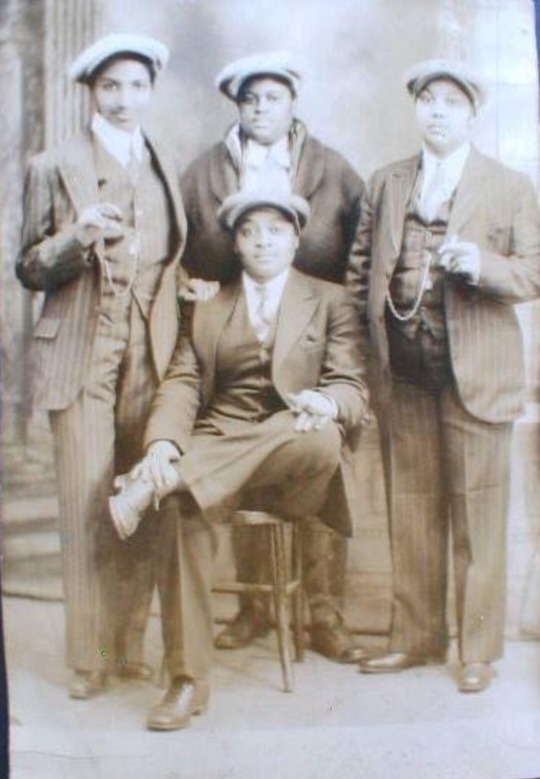
Black Lesbians from the 1930s.
This ain’t nothing new!
I had an aunt who dressed like these ladies and she identified herself as a “stud” , a word used in the lesbian community to identify a level of masculinity. My aunt had to endure sexism, racism and scrutiny more than I can imagine. She was “out” during the 50s and 60s, waaaay before the famous LGBT Stonewall riots that took place in NYC.
65K notes
·
View notes
Text
Love seeing women with bare faces, short fingernails, practical shoes, comfortable clothing, a full plate, a toothy grin, a relaxed posture. Love love love seeing women comfortable and happy and unselfconscious.
128K notes
·
View notes
Text
post-apocalyptic works by women
films:
pumzi, dir. wanuri kahiu
into the forest, dir. patricia rozema
fast color, dir. julia hart
literature:
ling ma, severance
louise erdrich, future home of the living god
anna kavan, ice
nnedi okorafor, who fears death
aliya whiteley, the beauty
emily st john mandel, station eleven
rebecca roanhorse, trail of lightning
carmen maria machado, “inventory”
jaqueline harpman, i who have never known men
nalo hopkinson, brown girl in the ring
nicola griffith, ammonite
tatyana tolstaya, the slynx
carmen maria machado, “a brief and fearful star”
cherie dimaline, the marrow thieves
sarah hall, daughters of the north
octavia butler, parable of the sower
tillie walden, on a sunbeam
doris lessing, memories of a survivor
nk jemisin, the fifth season
suzy mckee charnas, walk to the end of the world
marlen haushofer, the wall
sheri s. tepper, the gate to women’s country
pat murphy, the city, not long after
angela carter, heroes and villains
sally gearheart, the wanderground
462 notes
·
View notes
Text
If you’re looking for some radical feminist direct action to do I suggest joining your local buy nothing or mutual aid or other similar LOCAL group for your area on the evil face of books. I’ve noticed a steady stream of postings from women who are leaving abusive men and are in need of lots of basic necessities as they rebuild their lives. Most have children and are making posts asking for formula etc etc. This week I’m helping a woman in my area with 4 children who recently left an abusive man and is furnishing an empty apartment. I stole a new cast iron skillet and accessories for her. Help out your sisters. Radical Feminism is an action.
212 notes
·
View notes
Text
“We love our dead girls. We love them pretty, and we love them young: Aside from Houston, who was a practically ancient 48 years old at the time of her death, we have Amy Winehouse (27), Anna Nicole Smith (39), Princess Diana (36), Janis Joplin (27), Marilyn Monroe (36), Jayne Mansfield (34), Judy Garland (47), Zelda Fitzgerald (47)…and on and on, further and further back in time, probably back to the first woman who ever picked up a drink she couldn’t put down. The outpouring of love and grief that these women receive, in the wake of their deaths, tends to wipe their records clean. Amy Winehouse’s death caused much of the press to turn a complete 180 on her: NME Magazine, which had nominated her as one of its “Villains of the Year” in 2008, promptly rounded up celebrity quotes on her greatness once she was dead and thus incapable of further villainy. We’ve covered the most infamous profile of Winehouse, in which a reporter went to her house at four in the morning to cover the “little scabs that raid her face” and a photo of “Winehouse’s blurry face, taken from above with a phone in one hand and a gigantic penis in her mouth.” But it’s also notable that Rolling Stone, the same publication that made this story the cover, published tribute upon tribute after her death, opening one rapturous article by lamenting the fact that her “remarkable musical achievements were often overshadowed by her tumultuous personal life.” Well, yeah: You’re the ones who told the world about the dick-sucking photo. Where did you think the attention was going to gravitate? Similarly, during the massive international spectacle of Princess Diana’s death and funeral—the televised memorial service, with 3 million people in attendance and 2.5 billion watching at home; the streets full of flowers and weeping citizenry; the Elton John rewrite of “Candle in the Wind,” which became the best-selling single of all time—it was hard to even remember that the girl who was currently being eulogized as England’s Rose (You belong to heaven! Our nation lost without your soul!) had, in the last decade or so of her life, been portrayed as “crazy,” bulimic, and self-harming, addicted to media attention, and the subject of stories about how she’d thrown herself down flights of stairs and driven through Paris wearing only a fur coat and underpants. It did linger, a bit: It was too entrenched in her persona to do otherwise. In 1999, The New York Times endorsed author Sally Bedel Smith’s posthumous diagnosis of “borderline personality disorder,” and called Diana “unpredictable, egocentric, aggressive, insecure, manipulative, paranoid, possessive, easily bored, uneducated and a habitual liar.” (Sub-headline: “The author’s diagnosis explains why Diana was so rotten, but not why others seemed to like her.”) And yet, in the sea of flowers and tears and piano ballads, all seemed forgotten. Alive, she was a madwoman and a blight on the British crown. Dead, she was Ophelia, lost and lovely, garlanded and mourned as she passed downstream.”
— Trainwreck: The Women We Love To Hate, Mock, and Fear and Why, Sady Doyle
2K notes
·
View notes
Note
NIECY NASH!!!?
..........................................................what does this mean. hol on lemme google her
17K notes
·
View notes
Text
“The primary intent of women who choose to be present to each other, however, is not an invitation to men. It is an invitation to our Selves. The Spinsters, Lesbians, Hags, Harpies, Crones, Furies who are the Voyagers of Gyn/Ecology know that we choose to accept this invitation for our Selves. This, our Self-acceptance, is in no way contingent upon male approval. Nor is it stopped by (realistic) fear of brutal acts of male revenge. As Marilyn Frye has written: Male parasitism means that males must have access to women; it is the Patriarchal Imperative. But feminist no-saying is more than a substantial removal (re-direction, re-allocation) of goods and services because access is one of the faces of power. Female denial of male access to females substantially cuts off a flow of benefits, but it has also the form and full portent of assumption of power.”
— Mary Daly, Gyn-Ecology
257 notes
·
View notes









